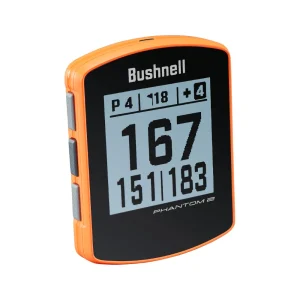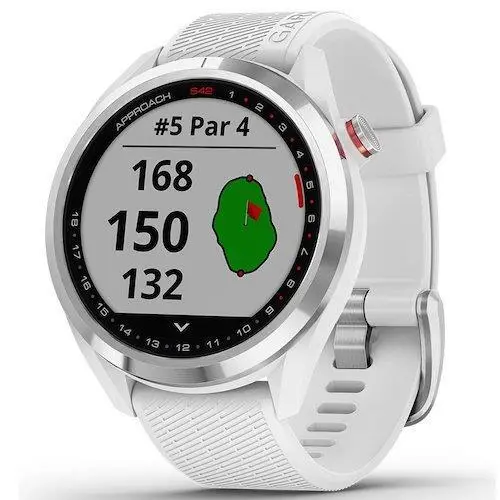Golf is a game of precision, and even the smallest error can significantly affect your score. In their pursuit of accuracy, golfers have embraced the usage of golf rangefinders, a groundbreaking instrument that has changed the way they approach their shots. But exactly what is a golf range finder, and how does it works? Today, let’s look into this topic.

What is a Golf Range Finder?
A golf range finder is a small, handheld device that measures the distance between the golfer and the target, usually the flagstick or another point on the course.
These devices use advanced technology like lasers or GPS to provide extremely accurate distance measures, allowing players to make informed judgments about club selection and shot strategy.
Types of Golf Range Finder
Golf range finders are widely classified into two types based on their underlying technology: laser range finders and GPS range finders:
1) Laser Range Finders:
These are the most often used range finders in golf. They function by directing a laser beam at a target and measuring how long it takes for the beam to bounce back after striking the object.
The range finder calculates the accurate distance to the target using the speed of light and the amount of time elapsed.

There are two major types of laser range finders:
1) Standard Laser Range Finders: These are the most basic and inexpensive laser rangefinders. They provide precise distance measurements to the destination but have no further features or sophisticated capabilities.
2) Slope-Compensated Laser Range Finders: These more modern laser range finders account for elevation differences between the golfer and the target, resulting in slope-adjusted distance estimations. This function is especially beneficial on steep or undulating courses since it helps golfers select the right club for uphill or downhill shots.
2) GPS Range Finders:
These devices use satellite technology to establish a golfer’s location and compute distance to pre-loaded course elements like greens and hazards.
GPS range finders are categorized into following types:
1) Handheld GPS Range Finders: These little gadgets look like standard laser range finders, but they employ GPS technology instead of lasers. They often include accurate course maps and distances to various course goals.

2) GPS Watch Range Finders: These range finders are constructed in the shape of a golf watch or wristband, making them highly practical and easy to use while playing. They show distance and course information on the watch face.

3) GPS Handheld/Cart Range Finders: These larger GPS range finders are intended to be mounted on a golf cart or transported in a golfer’s bag. They frequently have larger displays and include additional features including as hole flyovers, shot tracking, and complex course administration tools.
4) Smartphone GPS Apps: Many golfers choose to utilize GPS rangefinder apps on their smartphones, which take advantage of the phone’s built-in GPS capabilities. These apps usually require a membership or a one-time purchase and display distance information and course maps on the phone’s screen.

Within each type, there are numerous models and brands with varying features, pricing points, and levels of accuracy. Golfers can select the range finder that best meets their needs, preferences, and budget, ensuring they have the distance information they need to improve their game and make better shot decisions on the course.
How Does a Laser Rangefinder Works?
Laser rangefinders are among the most popular and commonly utilized tools on the golf course. These range finders function by directing a laser beam at a target and measuring how long it takes for the beam to bounce back after hitting the object.
The range finder uses the speed of light and elapsed time to compute the precise distance to the target with astonishing accuracy.
The laser range finder usually has a viewfinder or a tiny display that allows the player to point the laser beam toward a specific target, such as the flagstick or a bunker.
Once the laser beam has locked onto the target, the distance is displayed on the screen, typically in yards or meters, depending on the user’s selection.
One of the primary benefits of laser range finders is their ability to deliver accurate distance measurements even when the target is partially hidden by trees or other barriers. This makes them especially handy on courses with difficult terrain or densely forested areas.
How Do GPS Range Finders Work?
GPS (Global Positioning System) rangefinders work on a different concept than their laser cousins. These gadgets use satellite technology to establish the golfer’s location on the course and compute the distance to various objectives, including the green, hazards, and other pre-loaded course elements.
GPS range finders are normally preloaded with extensive course maps that are frequently updated to assure precise distance estimations. Some models even include advanced features such as hole layouts, green undulations, and shot tracking abilities.
When utilizing a GPS rangefinder, the golfer just selects the desired target on the device’s display, and the range finder calculates the distance. This strategy eliminates the need for manual aiming and lowers the likelihood of errors caused by obstacles or poor visibility.
Benefits of Using a Golf Range Finder
1) Course Management: Range finders assist players in better understanding the layout of the course, allowing them to spot potential hazards, plan their shots strategically, and make informed judgments on risk and reward scenarios.
2) Knowing the exact distance to the goal can boost golfers’ confidence, allowing them to swing with greater conviction and focus on executing their shots rather than second-guessing their club selection.
3) Improved Accuracy: Golf range finders provide precise distance readings, eliminating uncertainty in club selection and shot execution, resulting in more accurate and consistent strokes.
4) Faster Play: With the capacity to swiftly calculate distances, golfers may make more efficient judgments, decreasing the time spent arguing over club selection and contributing to a more fluid tempo of play.
Whether you like the accuracy of laser rangefinders or the ease of GPS technology, incorporating a golf rangefinder into your game will improve your overall performance and enjoyment on the course.
With correct distance information at your fingertips, you’ll be better prepared to face even the most difficult golf courses and elevate your game to new heights.
Disadvantages:
While golf range finders provide numerous benefits in terms of accuracy and shot planning, there are certain potential drawbacks that players should be aware of:
1) Learning Curve: While most range finders are intended to be user-friendly, there may still be a learning curve, particularly for golfers unfamiliar with the technology or sophisticated functions. Understanding how to use and understand distance information requires some time and practice.
2) Cost: High-quality golf rangefinders, particularly ones with advanced features such as slope adjustment or GPS capability, can be costly. Entry-level versions may be less expensive, but they may lack some features or have inferior accuracy.
3) Accuracy Limitations: While rangefinders are normally very precise, there are some elements that can influence their effectiveness. Laser range finders can be affected by atmospheric circumstances like fog or rain, whilst GPS range finders may have minor mistakes or outdated course data.
4) Risk of Distraction: Constantly checking the range finder or messing with its settings might become a distraction, potentially disturbing your attention and pre-shot routine. Overreliance on the technology might also impede the development of distance estimation abilities.
5) Battery Life: Both laser and GPS range finders are powered by batteries that must be replaced or recharged on a regular basis. Running out of juice during a round can make the rangefinder ineffective, thus affecting your performance.
6) Technology Dependence: Using range finders excessively can lead to a reliance on technology, thereby impeding players’ ability to develop their own distance estimate skills and course management tactics.
7) Pace of Play: If not used properly, repeatedly referring to the rangefinder or taking multiple distance measurements might slow down the pace of play, which is discouraged in golf etiquette.
8) Legal Restrictions: In some golf events or competitions, some range finder functions, such as slope compensation or club suggestions, may be forbidden in order to preserve the game’s integrity and level the playing field.
While these downsides should be considered, many golfers believe that the benefits of utilizing a golf range finder outweigh the possible negatives, particularly for those looking to improve their game and make better informed decisions on the course.
Proper use, smart energy management, and striking a balance between technology and traditional golf skills can help alleviate some of these drawbacks.
Substitutes of Golf Range Finders:
Yes, golfers can consider the following substitutions or alternatives to golf range finders:
1) Smartphone Rangefinder Applications: Apps can use built-in sensors like camera, GPS, and accelerometer to determine distances. While these apps can provide an approximate estimate of distance, they are typically less precise than dedicated laser or GPS range finders and may lack the same level of precision and additional capabilities.
2) Course Yardage Books or Markers: Many golf courses have yardage books or markers to indicate distances to specific spots, such as the middle of the green, bunkers, or hazards. While these tools can be useful, they may not provide the same level of precision or real-time distance information as rangefinders.
3) Laser Binoculars: These hybrid devices combine the capability of binoculars and a laser range finder. They give golfers a great view of the target while also providing distance readings. However, laser binoculars are more expensive than dedicated range finders and may not be as portable or practical to use on the course.
4) Experienced Golfers Can Estimate Distances Based on Course Familiarity and Past Experience. However, this strategy is primarily dependent on subjective perception and can be influenced by a variety of circumstances, including lighting conditions, terrain changes, and visual obstacles.
5) Pacing or Step Counting: Some golfers use pacing or step counting to assess distance. This method requires knowing the approximate length of their stride and counting the number of steps between a specified distance marker and the target. However, this method can be incorrect and prone to errors due to differences in topography, stride length, and other variables.
While these replacements can provide distance estimations, they may not be as accurate, consistent, or convenient as specialist golf range finders.
Range finders are specifically intended to offer accurate distance measures, allowing golfers to make more informed judgments about club selection and shot strategy.
For golfers looking to improve their performance and decision-making on the course, investing in a high-quality rangefinder may be the most dependable and efficient alternative.
Frequently Asked Questions:
1) What’s the difference between laser and GPS rangefinders?
Laser range finders employ a laser beam to directly measure the distance to a specific object, such as a flagpole or a bunker. GPS range finders, on the other hand, use satellite technology and pre-loaded course maps to calculate distances between various spots on the course, such as the green or hazards.
2) How accurate are golf rangefinders?
Both laser and GPS range finders are extremely accurate, however laser range finders are more exact, generally producing measurements within a yard or meter of the true distance. GPS range finders may have a little higher margin of error, although most current units remain accurate within a few yards.
3) What is the maximum range of a laser rangefinder?
A laser range finder’s maximum range varies, but most high-quality units can correctly estimate distances of 400-600 yards or more. However, their efficiency can be hampered by conditions such as fog, rain, or barriers to the laser beam.
4) Do I need to manually enter course data into a GPS rangefinder?
No, most contemporary GPS range finders are pre-loaded with detailed course maps and statistics for thousands of golf courses worldwide. The gadgets automatically display pertinent route information and distances based on your location.
5) Can rangefinders help in club selection?
Yes, one of the key advantages of utilizing a rangefinder is that it assists players in selecting the appropriate club for each stroke. Range finders eliminate guesswork from club selection by providing precise distance readings, allowing golfers to make more informed judgments.
6) How long do range finders’ batteries normally last?
Battery life varies by model and usage, but most high-quality rangefinders may last many rounds (18-36 holes) on a single charge or set of batteries. Some versions even include rechargeable batteries or power-saving settings to help increase battery life.
7) Can rangefinders be used during tournament play?
Range finders are normally permitted in most amateur and professional golf competitions, provided they follow the rules established by the regulating body (e.g., USGA or R&A). Certain features, like as slope modification and club advice, may be forbidden in some championships.

